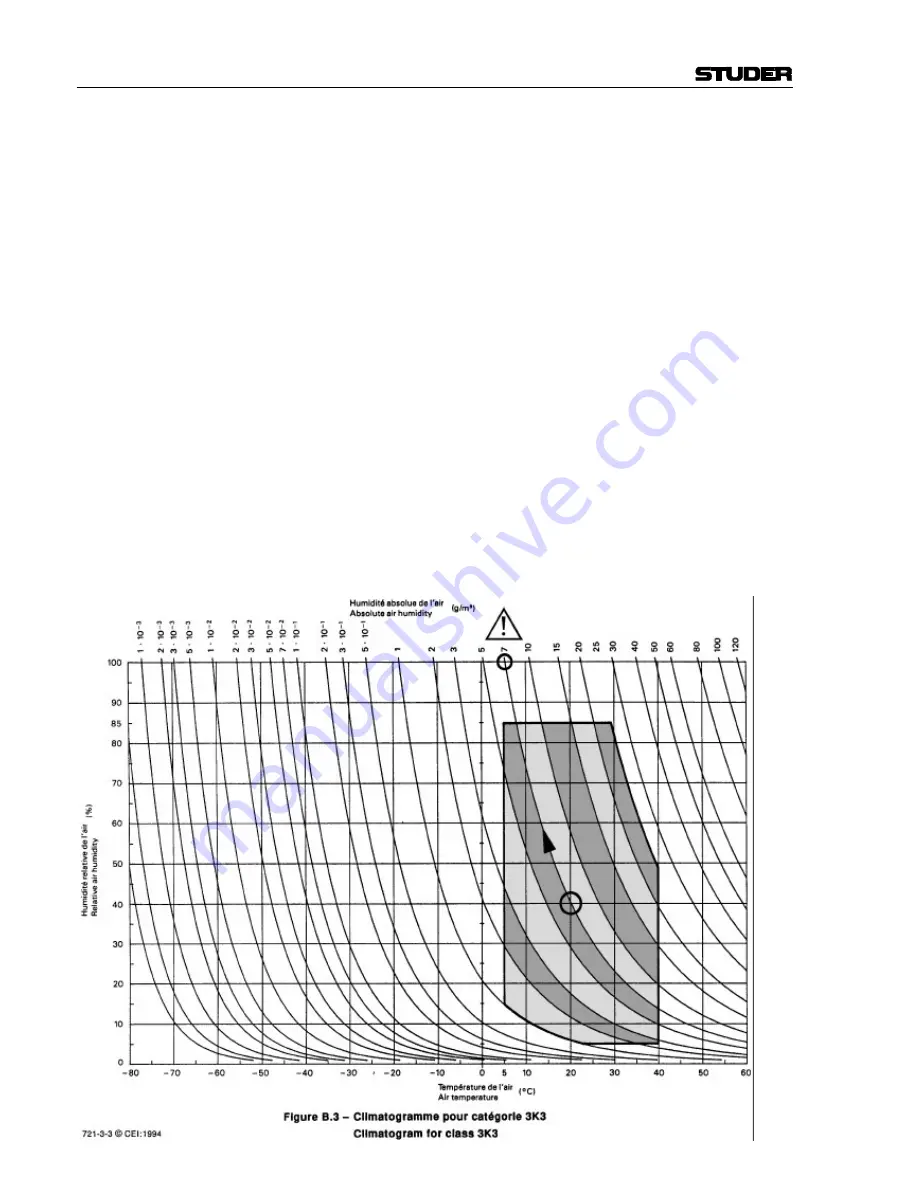
UMGEBUNGSBEDINGUNGEN / AMBIENT CONDITIONS
VI
Vor der Inbetriebnahme muss das System auf allfällige interne
Betauung oder Eisbildung überprüft werden. Nur bei sehr
leichter Eisbildung kann mit direkter Verdunstung (Sublimati-
on) gerechnet werden; andernfalls muss das System im abge-
schalteten Zustand gewärmt und getrocknet werden.
Das System ohne feststellbare interne Eisbildung oder Betau-
ung soll möglichst homogen (und somit langsam) mit eigener
Wärmeleistung aufgewärmt werden; die Lufttemperatur der
Umgebung soll ständig etwas tiefer als diejenige der Syste-
mabluft sein.
Ist es unumgänglich, das abgekühlte System sofort in warmer
Umgebungsluft zu betreiben, so muss diese entfeuchtet sein.
Die absolute Luftfeuchtigkeit muss dabei so tief sein, dass die
relative Feuchtigkeit, bezogen auf die kälteste Oberfläche im
System, immer unterhalb 100% bleibt.
Es ist dafür zu sorgen, dass beim Abschalten des Systems die
eingeschlossene Luft möglichst trocken ist (d.h. vor dem Ab-
schalten im Winter den Raum mit kalter, trockener Luft belüf-
ten und feuchte Gegenstände, z.B. Kleider, entfernen).
Die Zusammenhänge sind im folgenden Klimatogramm er-
sichtlich. Zum kontrollierten Verfahren gehören Thermometer
und Hygrometer sowie ein Thermometer innerhalb des Systems.
Beispiel 1:
Ein Ü-Wagen mit einer Innentemperatur von 20 °C
und 40% relativer Luftfeuchtigkeit wird am Abend abgeschal-
tet. Sinkt die Temperatur unter +5 °C, bildet sich Tau oder Eis.
Beispiel 2:
Ein Ü-Wagen wird morgens mit 20 °C warmer Luft
von 40% relativer Luftfeuchtigkeit aufgewärmt. Auf Teilen, die
kälter als +5 °C sind, bildet sich Tau oder Eis.
Before putting into operation, the system must be checked for
internal formation of condensation or ice. Only with a minute
formation of ice, direct evaporation (sublimation) may be ex-
pected; otherwise the system must be heated and dried while
switched off.
A system without visible internal formation of ice or condensa-
tion should be heated up with its own heat dissipation, as ho-
mogeneously (and subsequently as slow) as possible; the ambi-
ent temperature should then always be lower than the outgoing
air.
If it is absolutely necessary to operate the system immediately
within warm ambient air, this air must be dehydrated. In such a
case, the absolute humidity must be so low that the relative
humidity, related to the coldest system surface, always remains
below 100%.
Ensure that the enclosed air is as dry as possible when powe-
ring off (i.e. before switching off in winter, aerate the room with
cold, dry air, and remove humid objects as clothes from the
room).
These relationships are visible from the following climatogram.
For a controlled procedure, thermometer and hygrometer as well
as a thermometer within the system will be required.
Example 1:
An OB-van having an internal temperature of
20 °C and rel. humidity of 40% is switched off in the evening.
If temperature falls below +5 °C, dew or ice will be forming.
Example 2:
An OB-van is heated up in the morning with air of
20 °C and a rel. humidity of 40%. On all parts being cooler than
+5 °C, dew or ice will be forming.









































